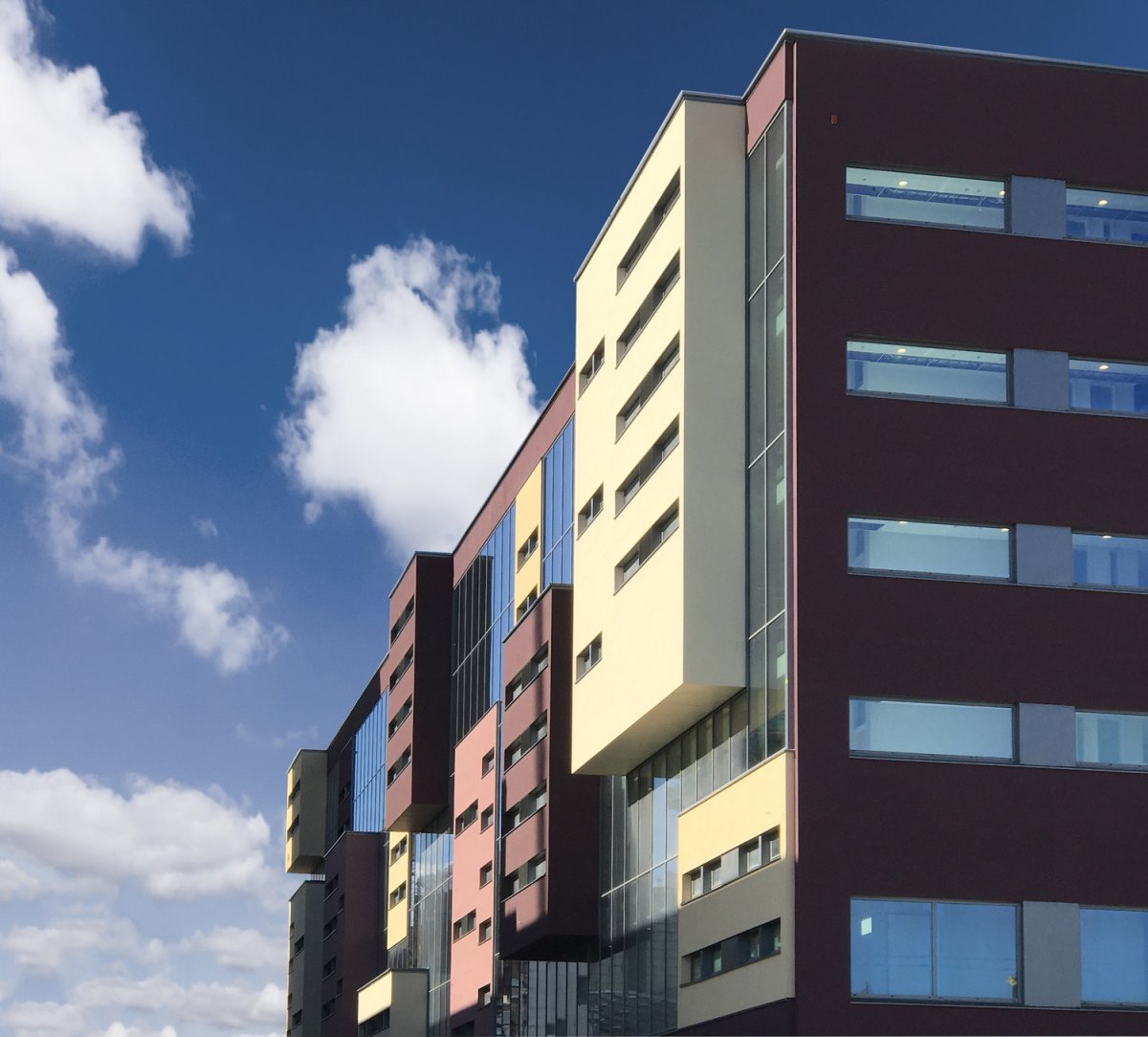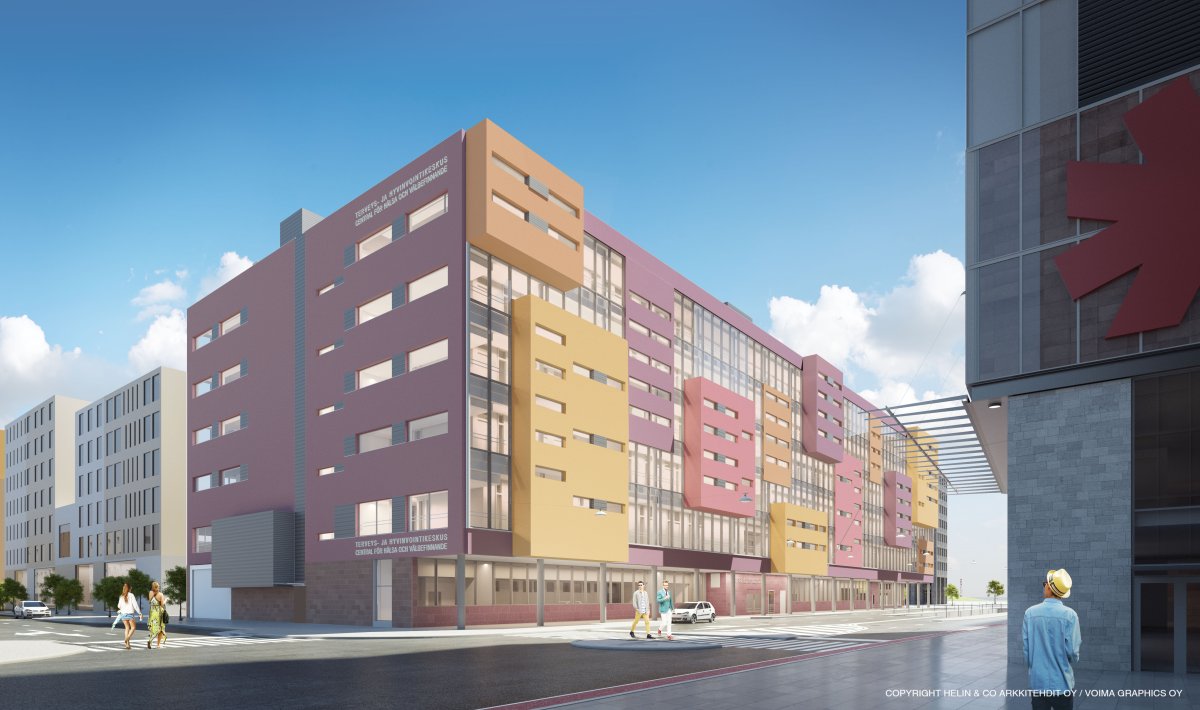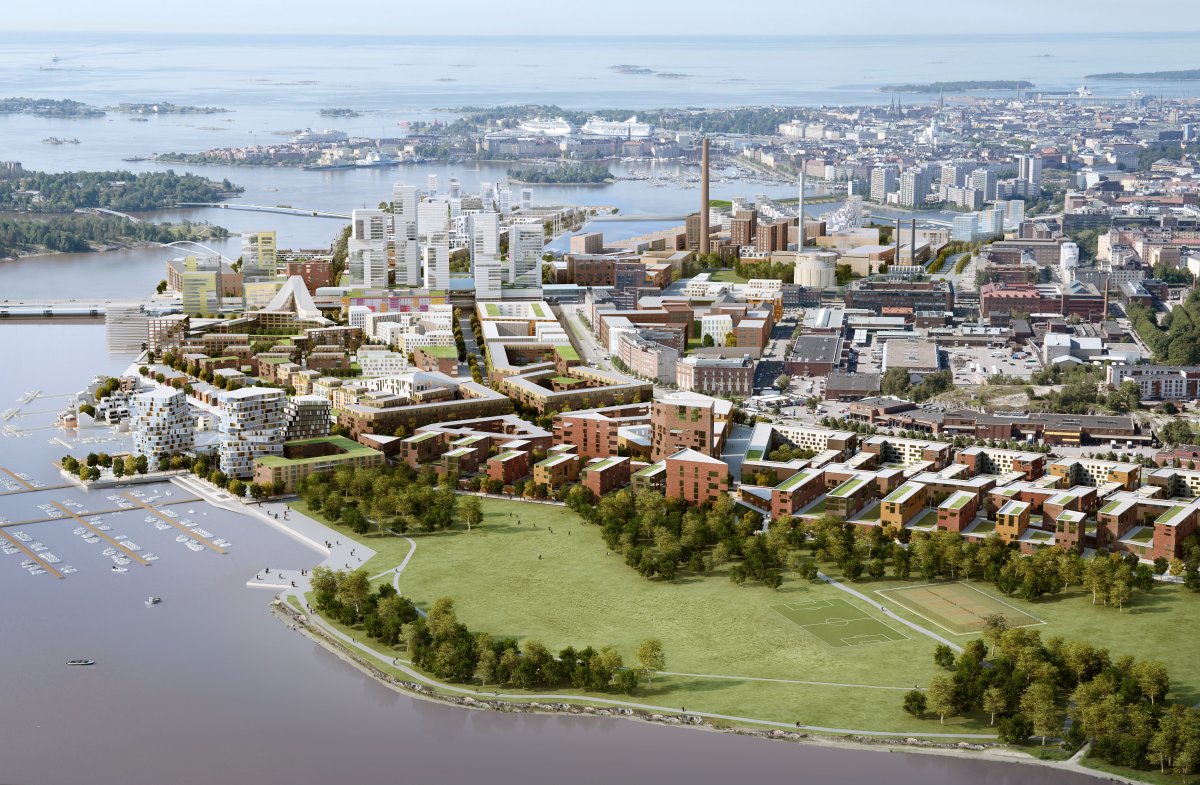Warm atmosphere, clarity, lots of daylight, novel functionality and, above all, user perspective instead of institutional look and exhausting corridors. These are themes that the designers of the Kalasatama Health and Well-being Centre mulled over when they started work on the new building at Helin & Co Architects, commissioned by the City of Helsinki.
– This has been a truly rewarding and interesting if also challenging job, says architect Ritva Mannersuo, principal designer of the building. She was involved in the project during the whole seven-year period of design.
The centre is easy to reach from the metro station and other public transport stops. The short walk from the metro is covered for the most part.
The building fills the 100-metre long and 36-metre wide plot almost entirely, which made the design of the facades quite demanding.
– We sketched the facade for a long time, for we did not want the building to look institutional. The exterior walls could not be glass throughout because of customer privacy. The blank parts provide a more sheltered place for people to wait for their turn, says Mannersuo.
Entry to the building is via an arcade. The spacious lobby is full of light, which comes, in addition to light fixtures and windows, from two imposing light wells. A nearly 20-metre-long mobile by artist Jenni Rope hangs down in each of them, yellowish in the eastern well and blue-hued in the western. The info point is located aptly opposite the main entrance, and signboards guide people to the right place. Just beside the main entrance, there is a dedicated space for information events and other services aimed at aging people. The entrance floor also contains a sampling laboratory. There is a restaurant open to all at the eastern end of the building, having a view of the sea and probably tables spread outdoors to form a terrace at summertime.
A unique centre
Ritva Mannersuo and architect Pekka Helin, who participated in the project in the concept development phase, say that this building combining health and social services is the first of its kind. There were no corresponding examples to be found in Finland or the world.
– On the same day we handed the building over to the client, a Japanese group of 30 experts came to familiarise themselves with it. They were extremely interested in Helsinki’s health and well-being model, unique even in the international context.
Focus on user perspective
Helsinki City authorities gave the functional guidelines to the designers, and special attention was to be paid to the user perspective. In the beginning there were workshops, where views of health care professionals and representatives of local inhabitants and disabled persons were heard, and model rooms were built where users could test how the consulting rooms would function.
The main functional idea is that professionals of diverse sectors work in close collaboration so that customers get the services they need smoothly.
The innermost part of the building contains background work facilities, where the personnel work when they are not consulting customers. Besides different kinds of workspaces, they contain a break area and kitchen as well as small, peaceful rooms for e.g. consultation by phone. Arranged into clusters, the workspaces allow for easy collaboration and communication. The retreat rooms have big, beautiful nature photographs printed on acoustic board. The pictures were taken by Susanna Tolvanen of Helin & Co, project architect of the building and an enthusiastic photographer. Despite being in the centre of the building, the background work facilities receive daylight from the light wells.
Skirting the perimeter are customer corridors. Frome these, customers enter consultation rooms, which are located between the corridor and the background work facilities. The respective expert comes in from the background area. The customer need not go from one expert to another, but experts come to the customer.
The spaces are lucid and fresh. Accessibility has been observed, for instance, in guiding lines and tiles as well as braille-printed and embossed signs. The corridors do not feel long, for they are split into sections by means of colours and projections. The colour palette features warm yellow and orange hues as well as grey and blue.
Sedum and meadow plants on the roof
Of the six above-ground floors of the building, four are similar with consultation rooms and background work areas. Dental care services are all on the first floor, which also houses maintenance of equipment and large meeting, teamwork and therapy rooms. The underground spaces contain parking for the personnel’s cars and bicycles and the staff facilities with showers and changing rooms.
The roof will be covered by sedum and meadow planting, which will absorb water and lessen the burden of the surface water drainage system. The vegetation will also lessen the need for cooling in summer. The green roof will be watered in the first summer, then nature will take care of it.
Users pleased with spaciousness and clarity
The starting point was to design flexible multi-use facilities, which support the new operation model and can be altered in the future, if need be, says Ritva Mannersuo.
Architect Pirjo Sipiläinen and project officer Hilkka Kulmala of the Social Services and Health Care Division of the City of Helsinki have asked about the first impressions of employees who are moving to the new building. The users have praised the good overall atmosphere. They do ponder what it will be like to work in the background work facilities and follow the new operation model. However, they are delighted by the spaciousness and clarity of the spaces of the building.
City of Helsinki Health and Well-being Centre, Kalasatama
- A customer-oriented centre combining social and health care services and following a new operation model. Functioning under one roof are services of health care, dental care and psychiatry as well as alcohol and substance abuse counselling, social counselling focussed on young people and adults, rehabilitation services and services for people with disabilities, and a HUSLAB sampling room.
- Gross floor area 23,000 square metres; six above-ground floors and basement.
- Design Helin & Co Architects. Principal designer Ritva Mannersuo, project architect Susanna Tolvanen.



